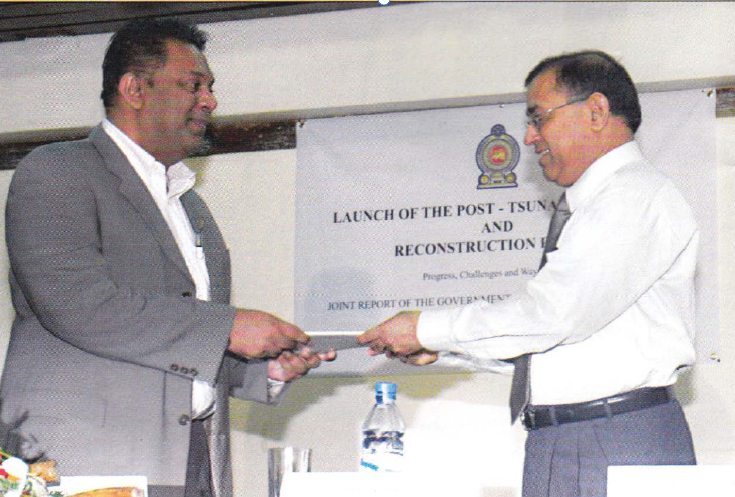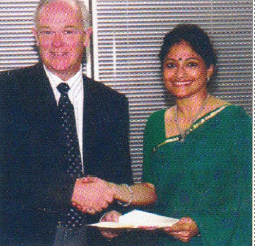By Anisha Niyas

The Government of Sri Lanka and the development partners released a joint Post Tsunami Recovery & Reconstruction Report in December. The report was a collaborative effort undertaken by the government and coordinated by a steering committee consisting of representatives of the government, civil society and the international community. In total, 20 government institutions such as the Ministry of Finance, National Planning Department and Task Force for Rebuilding the Nation (TAFREN); 20 bilateral and multilateral organizations like the Asian Development Bank (ADB), International Federation of the Red Cross (IFRC) and United Nations; and 18 national and international NGOs such as the Consortium of Humanitarian Agencies (CHA), contributed relevant information. The report was compiled through a comprehensive consultation process and highlights the challenges the country still faces. It aims to provide an objective joint assessment of post-tsunami relief, recovery and reconstruction interventions, and the way forward. Mangala Samaraweera, Minister of Foreign Affairs, Alessandro Pio, Representative of the Multilateral Group and Country Director of ADB, Abu Salim, Country Director of UNDP, and Jeevan Thiagaraja, Executive Director of the CHA, were present at the launch of the report. Speaking at the event, Alessandro Pio said, “The first post-tsunami challenge we face is coordination; coordination between central and local levels, between government agencies, and specially between individual donors and the formal donor community, all need to be improved. We owe this to all those who have suffered losses and to all those who are helping to overcome these challenges.”
Progress on issues such as subsidiarity, consultation, transparency and accountability were noted in the report as significant challenges, which still remain. This was specifically in regard to communication and coordination. Delivering the keynote address, Dr P B Jayasundera, Secretary, Ministry of Finance & Planning, stated, “We had a magnificent initial response, although we had problems with coordination. We need to make sure that we not only monitor but also that we learn from the mistakes we made. We can then provide better assistance in the future.” Analyzing the macroeconomic impact of the tsunami, Dr Jayasundera commented how it manifested into a reduced GDP by about 0.5-0.6 percentage points, which was reflected in the first quarter of 2005.
The Central Bank took immediate steps to arrest any tsunami-related adverse impacts on the financial markets, and foreign assistance in post-tsunami relief and recovery, including debt relief, provided the necessary fiscal space for prudent macroeconomic management. Despite the severe cost impact, the government was able to reduce inflation to below 10% by November 2005. The post-tsunami rehabilitation program was largely financed through foreign grants and concessionary financial assistance. The budget deficit will be kept at a manageable level aiming at macroeconomic stability, Dr Jayasundera said. “We looked at the tsunami as a challenge and an opportunity. It helped us focus on poverty-stricken areas of Sri Lanka that were affected by the tsunami,” he said. A phase of rehabilitation and reconstruction of national infrastructure in the affected areas has been entered into by the government with support from development partners. The government projects it would take 3-5 years to complete the rehabilitation and reconstruction task and fully restore the affected services and livelihoods. This effort will cost approximately US$2.2 billion. The international community has contributed US$2.l billion and an estimated US$0.6 billion has been disbursed. In addition, debt relief/moratorium and a balance of payments support have also been received.
It was recognized that permanent houses for all those affected would take time, thus transitional shelters were required in the interim. Out of the targeted 60,000 transitional shelters, 54,102 have been completed and 1,948 are nearing completion. Two programs for permanent housing to repair or rebuild damaged houses were also introduced. As of December 13, 2005, 10,707 permanent units were under construction and 4,299 completed. In addition, there are a large number of shelters and houses constructed by others, including religious centers, the private sector, individuals, etc. Affected families have received assistance through cash grants, food distribution, cash for work, and microfinance programs. Cash for work programs have spent an estimated Rs700 million.
Under the two main microfinance schemes and SME support schemes, more than 13,000 subsidized loans amounting to Rs3.8 billion have been disbursed. Towards restoration of livelihoods in the fisheries sector, 90% of all boats destroyed have been repaired or replaced. For those engaged in agriculture, seeds and fertilizer were distributed to approximately 80% of the affected areas. Desalinization of affected lands has also been undertaken. In tourism, 41 out of 52 damaged hotels are back in business. Tourism has not yet fully recovered as evident from the decline in total earnings by 10%, as of September 2005, despite an increase in the number of arrivals. It was reported that there were no outbreaks of water bourne diseases post-tsunami. Primary healthcare facilities and routine immunization and nutrition surveillance systems were established. In mental health, 500 community support officers have been trained and are deployed in affected areas. In relation to education, over 95% of school aged children in tsunami-affected areas have returned to school. Progress has already been made in integrating psychosocial care into the education system. Funds have also been provided for the rehabilitation of 180 damaged schools and construction work is in progress. The report states that the development of a disaster management and early warning system is making good progress. Equity among regions, ethnic groups and sectors remains critical and needs to be closely monitored. On the way forward post tsunami, the recovery and reconstruction process plays a vital role. The shared responsibility of the government and development stakeholders are to ensure that no one is left behind.
We looked at the tsunami as a challenge and an opportunity. It helped us focus on poverty stricken areas of Sri Lanka that were affected by the tsunami,” said Dr Jayasundera.
Also the pledges that were committed must be converted into disbursements, and results need too be seen on the ground. The report stressed the need to continue strengthening of the under-resourced capacity of local and district government levels. Minister Mangala Samaraweera commented that “management of the disaster was a monumental task and Sri Lanka has performed very well.” He added that Sri Lanka had successfully converted pledges into money and that the country’s reconstruction and rehabilitation process is tied to a durable peace process. The post-tsunami reconstruction and development program will now be accelerated through the new Reconstruction and Development Authority (RADA), which will function under the direct supervision of the President.




